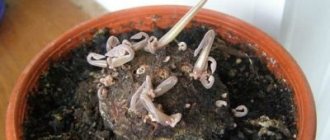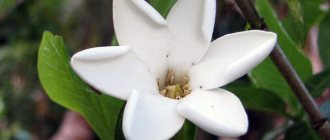Eucharis belongs to the category of bulbous crops of the Amaryllis family. The ornamental plant is widespread in South and Central America. The tropical crop is often called the Amazon lily. Experts count about 20 varieties of eucharis. Decorative foliage painted in rich green tones gives the plant a special gracefulness. During the flowering period, the culture emits an amazing aroma that spreads throughout the room. The diameter of the round bulbs of the Amazon lily can reach 50 mm. On top, the modified root system of the crop is densely covered with golden scales. Flower growers are often faced with the problem of a crop not flowering. Eucharis flower: care at home, why it doesn’t bloom and what can be done in this situation?
When do the buds appear?
The Amazon lily blooms for the first time of the year in spring. The second flowering may occur in August or early September. However, experienced gardeners often achieve flowering in any other period.
You can tell that eucharis is ready to bloom by the presence of babies. If they appear, then you can expect flowers to appear soon. The main thing is not to plant young shoots in a separate pot.
The timing of the appearance of the first flowers in a young one may be affected by the method of reproduction:
- Eucharis is most often propagated by division. With this method of propagation, the young flower will be able to bloom in the second year of life.
- Eucharis can also be propagated by seeds. This process is longer and it will only take 5 years to wait for flowering.
The question of when eucharis blooms is discussed in more detail on this page .
Eucharis care at home Why eucharis does not bloom Reproduction and transplantation Photos of flowers
An elegant indoor flower that appeared in subtropical forests on the banks of the Amazon River has two common names:
This flower is loved by gardeners for its unpretentiousness, beautiful flowering twice (three times) a year and a pleasant delicate aroma.
The following varieties are considered the most common for growing indoors: Eucharis grandiflora or grandiflora, Eucharis white, Eucharis toothless or Callifruria.
Eucharius has large, oval, pointed leaf blades. Their width is approximately 20 cm. Length is about 40 cm. Color is dark green. The leaf surface is slightly wrinkled, with prominent veins. The leaves of the plant live for several years. Young leaves are initially curled into a tube, but straighten as they grow.
The flowers are large (up to 10 cm), snow-white, slightly drooping downwards. They are found on long (up to 60 cm), straight, leafless stems.
Reasons for lack of flowering. What to do if only leaves grow?
Why does the Amazon lily not bloom at home, but only produce leaves? First of all, you need to pay attention to the watering regime of the flower. A possible reason is overwatering and overfeeding the plant . As a result, eucharis cannot independently enter the resting phase and actively grows foliage. And since it is during the dormant period that flower buds are formed in the bulb, there is no need to expect any flowering.
Attention! The reason for the build-up of excess green mass can be fertilizers containing nitrogen. An excess of this mineral element leads to increased leaf growth and lack of flowering.
Beginning flower growers sometimes associate the lack of buds with the fact that there are few leaves on the bulbs. But their number has nothing to do with flowering (except in extreme cases when there are none at all). Under standard conditions, each bulb has three to four leaves.
The Amazon lily likes to be relatively cramped in a pot. It follows that eucharis does not need a spacious container. It has been noticed that the plant does not bloom until it grows with children and completely takes over the space. Therefore, you need to plant even 3-5 bulbs in one pot, so the plants will spend less energy on the development of the root part and will bloom faster.
Also, lack of flowering can be a direct consequence of improper care. We talked in detail about caring for this plant here.
Transfer
How to replant indoor lilies? Replanting should be done every year with a complete replacement of the soil. During the flowering period of the lily, the soil manages to be depleted and loses most of its nutrients, so you may not be able to wait for the full development of the bulb and high-quality flowering.
The most important thing is the correct preparation of the bulbs for the dormant period and subsequent transplantation. After the above-ground parts die off, the bulbs are dug up and washed, clearing them of soil.
Small bulbs - the children are immediately selected and planted in seedling boxes. They will actively grow all winter, gaining strength.
Large bulbs are inspected, rot spots are cut out, treating the sections with crushed charcoal (charcoal or activated). If the stem has not yet fallen off, it needs to be cut off, leaving a stump 4-6 cm long. The bulbs are disinfected by immersing them in a solution of fungicides or potassium permanganate for 25-40 minutes. Then they are dried on paper or soft material and stored in the cold.
At the end of February - March, the bulbs are taken out of the bag and planted in a pot with soil.
Is it possible and necessary to stimulate the plant?
The flowering process is important for plants as it is the completion of the growing season. Plants bloom in order to be pollinated and reproduce. New young plants will appear from the formed seeds next year.
A plant may not bloom if it does not feel the need to reproduce. In this case, flowering can be stimulated by creating conditions of slight stress.
We are talking about forced transfer of eucharis into a period of rest , by:
- reducing watering;
- moving to a less lit place;
- lowering the room temperature.
In this way, experienced gardeners can make the plant bloom even at unusual times. And it’s easier to do this indoors, since it’s easier to control watering, lighting and temperature.
On the other hand, it is not always worth stimulating flowering; there is a risk that a weakened plant may stop blooming altogether . Therefore, experts recommend simply following the rules for keeping eucharis at home, then it will bloom on its own 1-2 times a year.
Problems during cultivation
If you follow all the rules of care, eucharis will delight you with its decorative foliage and abundance of fragrant inflorescences for many years. If gross mistakes are made, then problems will not take long to appear. Let's look at common errors and ways to eliminate them.
The leaves began to turn yellow. If the lower old leaves turn yellow one by one and die one by one, then this is a natural process. Their time has come. New leaves will grow in place of old leaves. If all the leaves, including young ones, begin to turn yellow, then check:
- What is your room temperature (at 10 degrees eucharis dies).
- quantity and quality of water during irrigation. You cannot completely dry out the soil, but you also cannot create a swamp in the pot. Water for irrigation should be soft, filtered, at least standing for 24 hours, at room temperature.
- Place where the flower is grown - if the pot has been in the sun for a long time, the leaves will burn and fall off.
This may be interesting: Indoor Cineraria - planting and care at home
Eucharis leaves have become limp. The reasons may vary. Perhaps you forgot to water the flower on time. Do this promptly and the castings will likely become springy again. If you forgot the flower near an open window in winter when ventilating the room, or did not cover it well during transportation, then the flower has become hypothermic and the turgor of its leaves may not be restored. Leaves also become sluggish when the roots are damaged. The flower can be saved. To do this, remove the plant from the pot and inspect the bulbs. Remove the rotten ones, cut the damaged ones with a clean knife to healthy tissue, treat the wounds with crushed coal or ash and plant in a new substrate. Water with added fungicide.
The leaves curl into a tube and become deformed. Typically, the plant rolls up its leaves in a dry room so that they evaporate less moisture. Wipe the leaves with a damp sponge to remove dust and provide access to water. Spray them daily. Young leaves emerge from the soil rolled into a tube and become deformed only if they receive mechanical damage during unfolding. If all the leaves are deformed, there may be several reasons:
- hypothermia of the soil and, accordingly, the root system;
- excess fertilizer;
- insect pests.
Falling leaves. If, with the appearance of new leaves, the old ones immediately begin to turn yellow and fall off, then the reason is the lack of resources to support the life of the flower, most often this is a lack of sunlight in winter. Provide additional artificial lighting for it, water it regularly and properly, avoiding waterlogging or drying out the root system of the flower, and feed it with suitable fertilizers.
Diseases
Gray rot. This disease is quite common in amaryllis flowers, which include eucharis. The causative agent of the disease is the fungus Botridis, which affects plants if their pot is in a damp room with a low temperature, or if cold water is used when watering. First, the leaves lose their elasticity, soften, then turn brown, become covered with gray mold and die.
For treatment, it is necessary to remove all leaves affected by the disease, and then treat the flower with products containing copper, such as copper sulfate, Fundazol or Topsin-M according to the instructions for the drugs.
Stagonosporosis on the bulb
Stagonosporosis (red burn). This disease affects eucharis if sharp temperature fluctuations of 8 degrees or more often occur in the room where its pot is located. In addition, the plant may become sick if it is constantly flooded or kept in cold conditions. At first, you will see elongated spots of bright red color begin to appear on the leaves, petioles, buds and bulbs. Then the leaves will begin to wither, the flower stalks and buds will bend and bend down. The bulbs will also rot. Eucharis will wither and die.
Don't wait for this, start treatment right away. Remove the bush from the pot. Free the bulbs from the soil and inspect. For damaged bulbs, cut off the rotten areas to healthy tissue, treat the sections with green paint. Let them dry out for a day or two and plant them in a new suitable substrate. Don’t make the same mistakes, because treatment does not always help preserve your favorite plant.
This may be interesting: Pachistachis - recommendations for care and reproduction at home
As a preventative measure, we recommend using healthy bulbs for planting, and if in doubt, treat the bulbs with some fungicide for 30 minutes before planting (for example, Rovral, Oksifom, Maxim), then dry them for a couple of days and plant them in new soil.
Pests
Eucharis is rarely attacked by pests. If you keep him in comfortable conditions, you have nothing to fear. If the temperature regime or watering regime is violated by you, then the parasites will be right there. Let's consider possible uninvited guests of the Amazon lily.
Spider mite. This parasite is bred on lilies in dry and hot rooms. You cannot see them with the naked eye, but you can see how a thin cobweb appears on the leaves, how they become covered with yellow specks, dry out, droop.
If you notice signs of these insects in time, then urgently treat the leaves and all above-ground parts of the plant with a solution of laundry soap. In case of massive damage, you will have to treat the eucharis with chemical acaricides, such as mite mite, fitoverm, acarin and others.
Shield. Dark spots called plaques appear on the inside of the leaves. They can be removed with a damp cloth, and in case of massive damage, treated with an insecticide.
Sciarids (Fungus gnats) . If the soil in the pot is constantly waterlogged, then black midges will grow in it. Females lay their eggs directly on the roots of the plant. The larvae hatching from the eggs feed on the sap and tissues of the roots of the onion and inhibit it. As a result, the plant weakens and is no longer able to grow or bloom.
Treat (water) the soil with Aktara solution according to the instructions several times until the sciarids are completely destroyed. In the future, adjust the frequency of watering and the volume of water used for one watering. The soil should dry out well at least a third of the pot between waterings. Gently loosen the top layer of soil so that it dries better.
Amaryllis scale. The pest settles in the scales of the bulb. Leaves and flower stalks become bent and lose their original shape. The bush dries out and may die. The worm usually gets onto a healthy plant from diseased bushes (for example, in a store).
For treatment, use insecticides such as Aktara, Akarin or Vertimek. Both the soil and the entire plant should be sprayed. (Read instructions).
What conditions are required for the natural process?
In order for the plant to feel comfortable and bloom independently, it is necessary to create conditions similar to those found naturally in their native environment.
Reference! Eucharis loves space and takes up a lot of space. It is best that no other plants are located near the pot. If the pot is on the windowsill, there is no need to place neighbors next to it.
Lighting
Under natural conditions, Eucharis is found in the lower layers of the rainforest, so it does not like direct sunlight . If you want to put a flower pot on the windowsill, it is better to let it be an east or west window.
From the scorching sun, burns appear on the leaves of eucharis. During hot periods, it is better to remove the flower pot from the window and place it in a well-lit place, but protected from sunlight.
Watering
Eucharis does not like a lot of water. It should be watered only when the earthen ball has dried out by 3 cm. Excessive moisture can cause the bulb to rot . During the dormant period, watering is reduced, allowing the soil to dry out by two-thirds of the pot. You can water eucharis in a tray or directly into a flower pot, but you must avoid getting water on the bulb itself.
Eucharis is still a tropical plant, so the air humidity should be quite high. Frequent spraying of the leaves will be helpful. At the same time, it is strictly forbidden to allow moisture to get on the flowers. A good alternative is to wipe the leaves with a damp sponge. You can also place a cup of water next to the plant.
Important! Tap water is not suitable for irrigation. It is best to collect it in advance and leave it for about a day in an open container. The water should be at room temperature.
Temperature
- In summer, the most comfortable temperature for eucharis will be 22 0C. It is important to avoid sudden changes in temperature during the day - this will lead to a decrease in the size of the flowers.
- In winter, during the dormant period, eucharis can be kept at a temperature of about 15 0C.
- For comfortable growth you need at least 18 0C.
Feeding
Eucharis should be fed only during the period of growth and flowering. It is recommended to apply fertilizer once every 2 weeks. During the dormant period, fertilizing should not be carried out .
Eucharis will not bloom if the soil is oversaturated with nitrogen. It is better to opt for organic fertilizers.
Transfer
Eucharis does not like frequent .
- An adult plant should be replanted no more often than once every 3 years in the spring.
- It is better to plant several bulbs in one pot. This way the root system will develop faster and the possibility of flowering will appear.
- After transplanting, you need to stop watering for a couple of weeks.
Transshipment is considered the best way to transplant eucharis . The flower should be replanted into a new pot together with a lump of earth.
A drainage layer is needed at the bottom of the pot. Traditional expanded clay is well suited for this. The soil for planting must be nutritious and moisture-absorbing.
You can use ready-made soil for flowering plants, or you can mix leaf soil, sand and humus.
We looked at the composition of the soil for eucharis in detail here.
Eucharis flower
The main advantage of the eucharis flower is that, unlike other amaryllis, it does not lose its high decorative value all year round: its dark green shiny leaves look very impressive even during the dormant period. The leaf blade of Eucharis is large, up to 40 cm long and 20 cm wide, slightly wrinkled, with pronounced longitudinal veins. During the dormant period, indoor eucharis may lose a leaf or two, but no more, unless this is associated with some disease.
The eucharis bulb is round in shape, up to 5 cm in diameter, all covered with golden-brown scales. Bulbs of different ages may produce flowers at different times, and if you plant different sized bulbs in the same pot, you will get a long-blooming plant. Narcissus-like fragrant flowers 10-12cm in diameter are located on a long (60-70cm) peduncle. They are usually white, but sometimes cream or bluish. The flowers are collected in inflorescences of 2-6 pieces, in the middle of each flower there is a core with a jagged border.
How to make an Amazon lily shoot out an arrow: step-by-step instructions
If the Amazon lily is not happy with its flowering, you can help it a little. To do this, you need to create special conditions and force the plant to retire :
- Move the plant to a darker place.
- Reduce the temperature to 15 0C.
- Reduce watering the plant. Water only when the earthen ball dries out to two-thirds of the container.
- Be sure to stop any feeding.
After a month or two, the plant can be returned to its usual conditions. Usually, after taking these measures, eucharis blooms .
Eucharis is unpretentious in care and even a novice gardener can cope with its maintenance. By adhering to all the rules for caring for the plant, you can achieve effective flowering of eucharis every year.











